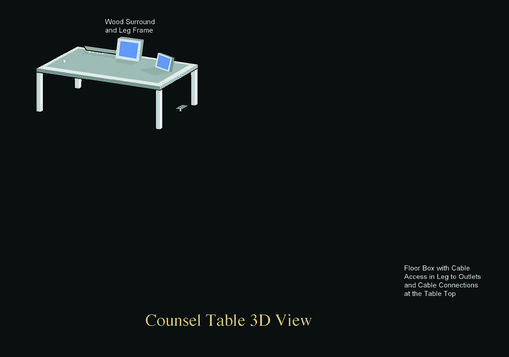A variable number of attorneys may appear before the court, but provision should be made for the typical two to four persons, including the litigants, at each table. The attorney table work surface should be sufficient to handle legal texts, documents, case notes, evidence, and equipment such as laptop computers and tablets.while allowing for comfortable seating and movement of the parties at the tables. Attorneys and litigants should be able to confer in private without being overheard. Attorneys should be able to move easily in the litigation area and be able to approach a lectern or any other participant in the case.
|
|
The design and image of the attorney tables should be compatible with the style and finishes of the judge's bench and other courtroom furniture. There should be a separation between the attorney tables of 4’ or more, and they should be positioned to reflect equal status. The tables should be movable. A modesty screen should be considered if prisoners are ever shackled in the courtroom.
It is recommended that each courtroom have separate tables for the defense and plaintiff (or prosecution). The tables should never be connected in order to facilitate private client/attorney communications and to decrease the potential of violence between the parties.
The attorney tables should be at least seven feet long (and eight to ten feet long if multiple litigants or attorneys are common). The table top should be three to four feet wide to accommodate the necessary work materials. The area of each attorney table, including attorney chairs and two-foot movement space behind the chairs, should be approximately 55 to 80 square feet.
Attorneys should be able to see and hear all courtroom participants clearly. The litigation area lighting above the counsel tables should be augmented with direct incandescent task lighting. Glare or reflection from the tables should be reduced.
The attorney tables should be accessible with adequate access to the work area and maneuvering room behind the tables. If provided, microphones should be movable and have a long neck.
The attorney tables and their placement should enhance the attorney's in-courtroom work and movement throughout the litigation well. The tables should face the bench and provide a full view of the judge, court reporter, witness, and jury.
To prevent private conversations from being overheard or documents from being read, attorney tables should be four to five feet apart and approximately six to eight feet from the nearest juror or spectator.
A distance of 10 to 16 feet is required from the front of the judge's bench to the front of the attorney tables. This distance creates the symbolic image of judicial objectivity and dignity while forming an area within which attorneys may move and that may accommodate additional attorney tables if necessary.
The back edge of the attorney table should be aligned with, but not ahead of, the end of the jury box. This ensures that no juror is out of the attorney's field of vision, an important factor during the questioning of witnesses.
The distance between the back of the attorney chairs and the bar should be approximately five to six feet to accommodate comfortably an additional row of chairs or benches along the railing for staff, paralegals, or other involved parties and to allow for a pathway behind the attorney tables.
The primary access of attorneys and parties to the attorney tables should be from the public circulation corridor and through the seating area. Other points of access include the prosecutors' entrance from a private corridor and the entry for persons in custody from the secure corridor.
The tables should not have drawers or concealed recesses where a weapon or bomb may be placed. Furniture should be of sufficient weight that it cannot be picked up and used as a weapon.
The attorney tables should not have glossy finishes that may reflect light and create a glare on the writing surface. The chairs provided for the parties may be swiveling armchairs with casters.
In some jurisdictions, a movable lectern with a microphone may be available. If use of a lectern is required by the court, the court should provide either an adjustable lectern (or portion of) or a fixed lectern with the counter or desk height between 28” and 30” above the floor, and knee space at least 27" high, 30" wide and 19" deep. In addition to this accessible portion of the lectern, it may contain a non-accessible counter or desk at approximately 28” to 30” high for seating and 42” for standing positions. A 30" x 48" clear floor shall be provided at each accessible lectern. A movable lectern which is designed to be accessible to someone in a wheelchair can be provided within the courts facility and moved to a particular courtroom when needed. Such a lectern is commercially available for purchase.
Task lighting may be provided to aid in reading. The lectern should be easily accessible from the attorney tables and should not interfere with the view of the proceedings by the litigants or the jurors.
Electrical receptacles and cable conduits for built-in computer display terminals should be provided for the purpose of accessing law databases, reviewing taped depositions, video display evidence, exhibits, and case transcripts. There should be flush floor-mounted outlets for microphones and a closed-circuit television system; telephone lines should be at each attorney table so that attorneys may be connected to their office computers by means of a modem.

